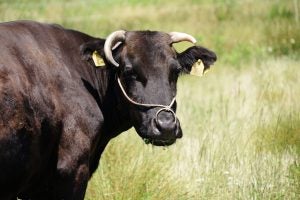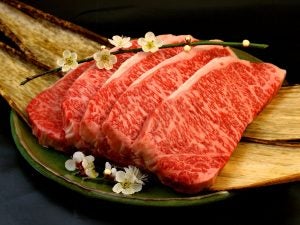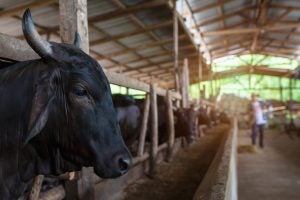From the unique marbling of the beef to the limited export market, Japanese Wagyu cattle have sparked intrigue and a growing following in the U.S.
Whether a large producer or a homesteader raising beef for the family, cattle-folks know the value of marbling their meat. But in addition to the big breeds so well known to American beef producers, a number of foreign lines have made their way into the herds over years — and among the best in terms of marbling quality is the Japanese Wagyu. Literally translating as “Japanese Cow” (Wa = Japanese, Gyu = cow), the breed was first introduced to the U.S. in 1976, and today boasts about 40,000 American head, crosses included. Considered a delicacy in Japan, where it fetches as much as $150 per pound, American producers like crossing the Wagyu with Angus and Holstein.
Whether a consumer or a producer, introducing some Asian blood into the herd might be worth the consideration. And as it’s not a breed with which many Americans are familiar, here are six Japanese Wagyu cattle facts to help get you started. This isn’t intended to be an exhaustive summary of the breed, but they should wet the tastes of those interested and who want a primer on it. For more in-depth information, visit some of the additional resources the American Wagyu Association.
1. Interesting history
Getting your hands on pure Wagyu has been tough over the years. Live animal and DNA transport from Japan was banned prior to, and after 1997, making for a small window in the breed’s history. In fact, the meat itself was actually banned for export up until 2012, and even now there is a stiff quota and tariff system in effect. Of the head in America today, only about 26,000 are purebreds, out of some 89.9 million total cattle.
Still, there is DNA in the Western Hemisphere for producers interested. In 1976, four bulls were sent from Japan to the outside world, and Colorado University obtained semen collections, which were subsequently sold to Wagyu Breeders Inc. As there were no Wagyu females in the U.S. at the time, the two Wagyu Black and two Wagyu Red bulls were bred to Angus, Hereford, and Brangus cows out of Texas. Generations later though, producers can get a purer strain by way of the numerous Wagyu associations that have developed now around the world.
For more information on how to obtain pure genetics, check out the Breeders Guide of the American Wagyu Association or Wagyu International.

2. The fab four
In Japan, the breed maintains four groupings: Japanese Black, Japanese Brown, Japanese Shorthorn, and Japanese Polled. Prior to the 20th century, the Japanese Black cattle were considered the workhorses of that islands farms. Improved through the years by crossbreeding with foreign cattle, that grouping now accounts for 90 percent of Wagyu raised in Japan, with a slaughter age of 28 to 30 months and average grade there of BMI 5.6. The Japanese Brown on the other hand tends to produce a lower fat content and leaner meat, with an average Japanese Grade of BMS 3.2 and slaughter age of 25 months. The Japanese Shorthorn comes primarily from the Tohuku Region and is the result of long series of mating interactions with the Nanbu Cattle. Much leaner than the Japanese Black, the Shorthorn has a BMS of 3 or below. The youngest of the breeds is the Japanese Polled, which was created by crossing the Aberdeen Angus from Scotland with the Japanese Black in 1920. The smallest of the four, the Japanese Polled is also the leanest of the four.
3. Size matters
Numbers will vary among producers, but a study published in the Asian-Australasian Journal of Animal Sciences recorded mean body and carcass weights of Japanese Black cattle at slaughter to be 756 kilograms (1,666.69 pounds) and 476 kilograms (1,049.40 pounds), at 29.2 months of age. Mean daily weight gain to slaughter was 0.77 kilograms (1.697 pounds).The same 2018 study showed 26-month old Wagyu steer carcasses to be 47.7 percent muscle, 41.7 percent fat, and 10.6 percent bone, which represented the highest level of fat when compared to Belgian Blue cattle, Holstein, and German Angus.

4. Fat and juicy
With up to 300 percent more monosaturated fat than other beef, the Wagyu beef is significantly higher in Omega 3 and 6 content as well, and has the highest amount of conjugated linoleic acid (CLA) per gram relative to other beef by a factor of 30 percent due to linoleic acid levels. To that degree, the beef has a fat profile comparable to salmon and olive oil, while boasting lower cholesterol levels then chicken. With stats like that, it’s easy to understand why people describe the beef as having a unique flavor and downright buttery feel. More than 90 percent of Wagyu slaughtered in the U.S. are classified “Prime,” which is the highest marker, with marbling described as “slightly abundant to abundant,” with a minimum intramuscular fat content of 8 to 11 percent.
5. Where’s the beef?
While not available just anywhere in the U.S., a number of brick-and-mortar locations do retail Wagyu beef, and there are several online. Prices vary widely by retailer, as with all products. Snake River Farms of Idaho is one of many operations specializing in Wagyu, with a number of cuts and bulk provisions available through their website. Prices for products range anywhere from $14 per pound for ground beef, to $399 for prime rib. Traditional brick-and-mortar options include Costco, with 10-packs of 10-pound ground beef going for $99.99. For producers looking to incorporate the Wagyu into their own herd, the American Wagyu Association offers a number of contacts.

6. Wagyu myths
Because of the limited exports, a number of downright hilarious myths have arisen to explain their high fat content. One of the more amusing is that Japanese farmers massage their cows while feeding them beer and playing classical music to help them relax. All experts agree, this is manure spread about the diner. Observers of Japanese farms might have mistaken traditional brushing techniques for massage, and various grain concoctions might have an aroma to them, but the Wagyu farms are not day spas.
Curious about other breeds? Here are 7 facts about Black Angus cattle, 7 facts about Hereford cattle, as well as a list of the most popular cattle breeds in the U.S.
Brian Boyce is an award-winning writer living on a farm in west-central Indiana. You can see more of his work at www.boycegroupinc.com.


